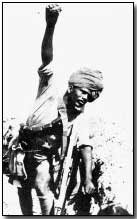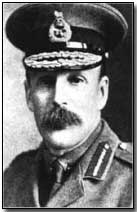Battles - The Capture of Baghdad, 1917
 Fresh from the triumph of
re-capturing Kut-al-Amara
in February 1917, British regional Commander-in-Chief
Sir Frederick
Stanley Maude halted operations at Aziziyeh, awaiting confirmation from
London to proceed onwards to Baghdad, less than 70km away.
Fresh from the triumph of
re-capturing Kut-al-Amara
in February 1917, British regional Commander-in-Chief
Sir Frederick
Stanley Maude halted operations at Aziziyeh, awaiting confirmation from
London to proceed onwards to Baghdad, less than 70km away.
Although the pause was brief - operations were renewed within a week, on 5 March 1917 - it gave regional Turkish Commander-in-Chief Khalil Pasha a short opportunity to consider his options for the inevitable defence of Baghdad, the Ottoman Empire's southern capital.
Khalil had some 12,500 men directly available to him, including around 2,300 survivors of the fall of Kut. Also en route to Baghdad, recalled from western Persia, were two divisions of 20,000 men under Ali Ishan Bey; however it was unlikely that Ishan's force would arrive in time to give Khalil meaningful assistance.
Khalil considered three options: a simple retreat beyond Baghdad, with its consequent humiliation of Turkish interests; to form a defence directly in front of Baghdad; or a attempt at an aggressive 'forward' defence.
In the event Khalil proved indecisive. Having begun work on fortifications at Ctesiphon (scene of an earlier successful demonstration of a Turkish forward defence) he abandoned work, choosing instead to defend Baghdad itself. To this end he formed defences either side of the River Tigris 35km south of the city and placed the Turkish Sixth Army to the south-east of Baghdad along the Diyala River.
Curiously, Khalil discounted the option of flooding the overland approaches to Baghdad which Maude's Anglo-Indian force would have had to traverse. The threat of flooding remained a constant threat and worry for the British beyond the capture of Baghdad.
 Maude
restarted his advance on 5 March along the east bank of the Tigris. Three
days later the British had reached the Diyala. An immediate British
attempt to cross the heavy, rapid-flowing river failed, although night-crossings
did succeed in establishing a small bridgehead the following evening.
Maude
restarted his advance on 5 March along the east bank of the Tigris. Three
days later the British had reached the Diyala. An immediate British
attempt to cross the heavy, rapid-flowing river failed, although night-crossings
did succeed in establishing a small bridgehead the following evening.
Recognising his difficulties along the Diyala Maude ordered the bulk of his forces to cross to the west bank by pontoon bridge several kilometres downstream, aiming to outflank Khalil and move directly on Baghdad.
Khalil was made aware of British intentions by the newly-arrived German Army Air Service; he consequently despatched the majority of his own force across the Tigris to meet the British, leaving a sole regiment to defend the Diyala position.
This was promptly taken by the British on the morning of 10 March; Khalil decided therefore to retire from his position at Tel Aswad to instead protect the Baghdad-Berlin railway. Sandstorms ended operations for the day; by the time the weather had settled Khalil had decided upon a general retreat from Baghdad itself, discounting German recommendations for a counter-attack. Thus at 8pm on 10 March the evacuation of Baghdad was underway.
Anglo-Indian troops entered the city without a struggle the following day amid loud celebrations from Baghdad's 140,000 occupants; approximately 9,000 Turkish prisoners were taken. Aside from striking a decisive propaganda blow for the Allies - the fall of Baghdad was of far less strategic than political value - its fall effectively brought to an end Turkish activity in Persia.
Maude himself barely paused to savour success at Baghdad before continuing onwards to seek the capture of the railway at Samarrah, after which wide-scale operations were largely halted until the autumn.
Click here to read the official Austro-German report into the fall of Baghdad written by Dr Gaston Bodart. Click here to read Maude's official despatch detailing the city's fall. Click here to read the war reporter Edmund Candler's account of the reaction of the people of Baghdad.
Click here to view a map charting operations at the time of the fall of Baghdad.
Photographs courtesy of Photos of the Great War website
'minnie' was a term used to describe the German trench mortar minnenwerfer (another such term was Moaning Minnie).
- Did you know?
